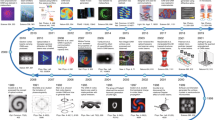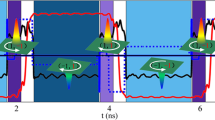Abstract
Vortex-carrying matter waves, such as chiral electron beams, are of significant interest in both applied and fundamental science. Continuous-wave electron vortex beams are commonly prepared via passive phase masks imprinting a transverse phase modulation on the electron’s wavefunction. Here, we show that femtosecond chiral plasmonic near fields enable the generation and dynamic control on the ultrafast timescale of an electron vortex beam. The vortex structure of the resulting electron wavepacket is probed in both real and reciprocal space using ultrafast transmission electron microscopy. This method offers a high degree of scalability to small length scales and a highly efficient manipulation of the electron vorticity with attosecond precision. Besides the direct implications in the investigation of nanoscale ultrafast processes in which chirality plays a major role, we further discuss the perspectives of using this technique to shape the wavefunction of charged composite particles, such as protons, and how it can be used to probe their internal structure.
This is a preview of subscription content, access via your institution
Access options
Access Nature and 54 other Nature Portfolio journals
Get Nature+, our best-value online-access subscription
$29.99 / 30 days
cancel any time
Subscribe to this journal
Receive 12 print issues and online access
$259.00 per year
only $21.58 per issue
Buy this article
- Purchase on Springer Link
- Instant access to full article PDF
Prices may be subject to local taxes which are calculated during checkout




Similar content being viewed by others
Data availability
The data that support the findings of this study are available from the corresponding author upon reasonable request.
References
Rubinsztein-Dunlop, H. et al. Roadmap on structured light. J. Opt. 19, 013001 (2017).
Yao, A. M. & Padgett, M. J. Orbital angular momentum: origins, behavior and applications. Adv. Opt. Photon. 3, 161–204 (2011).
Gibson, G. et al. Free-space information transfer using light beams carrying orbital angular momentum. Opt. Express 12, 5448–5456 (2004).
Bozinovic, N. et al. Terabit-scale orbital angular momentum mode division multiplexing in fibers. Science 340, 1545–1548 (2013).
Sit, A. et al. High-dimensional intracity quantum cryptography with structured photons. Optica 4, 1006–1010 (2017).
Grier, D. G. A revolution in optical manipulation. Nature 424, 810–816 (2003).
Padgett, M. J. & Bowman, R. Tweezers with a twist. Nat. Photon. 5, 343–348 (2011).
Mair, A., Vaziri, A., Weihs, G. & Zeilinger, A. Entanglement of the orbital angular momentum states of photons. Nature 412, 313–316 (2001).
Leach, J. et al. Quantum correlations in optical angle–orbital angular momentum variables. Science 329, 662–665 (2010).
Zilio, P., Mari, E., Parisi, G., Tamburini, F. & Romanato, F. Angular momentum properties of electromagnetic field transmitted through holey plasmonic vortex lenses. Opt. Lett. 37, 3234–3236 (2012).
Bliokh, K. Y., Bliokh, Y. P., Savel’ev, S. & Nori, F. Semiclassical dynamics of electron wave packet states with phase vortices. Phys. Rev. Lett. 99, 190404 (2007).
Bliokh, K. Y. et al. Theory and applications of free-electron vortex states. Phys. Rep. 690, 1–70 (2017).
Lloyd, S. M., Babiker, M., Thirunavukkarasu, G. & Yuan, J. Electron vortices: beams with orbital angular momentum. Rev. Mod. Phys. 89, 035004 (2017).
Larocque, H. et al. ‘Twisted’ electrons. Contemp. Phys. 59, 126–144 (2018).
Edström, A., Lubk, A. & Rusz, J. Elastic scattering of electron vortex beams in magnetic matter. Phys. Rev. Lett. 116, 127203 (2016).
Grillo, V. et al. Observation of nanoscale magnetic fields using twisted electron beams. Nat. Commun. 8, 689 (2017).
Uchida, M. & Tonomura, A. Generation of electron beams carrying orbital angular momentum. Nature 464, 737–739 (2010).
Verbeeck, J., Tian, H. & Schattschneider, P. Production and application of electron vortex beams. Nature 467, 301–304 (2010).
McMorran, B. J. et al. Electron vortex beams with high quanta of orbital angular momentum. Science 331, 192–195 (2011).
Mafakheri, E. et al. Realization of electron vortices with large orbital angular momentum using miniature holograms fabricated by electron beam lithography. Appl. Phys. Lett. 110, 093113 (2017).
Béché, A., Van Boxem, R., Van Tendeloo, G. & Verbeeck, J. J. Magnetic monopole field exposed by electrons. Nat. Phys. 10, 26–29 (2014).
Verbeeck, J. et al. Demonstration of a 2×2 programmable phase plate for electrons. Ultramicroscopy 190, 58–65 (2018).
Pozzi, G., Lub, P.-H., Tavabi, A. H., Duchamp, M. & Dunin-Borkowski, R. E. Generation of electron vortex beams using line charges via the electrostatic Aharonov–Bohm effect. Ultramicroscopy 181, 191–196 (2017).
Handali, J., Shakya, P. & Barwick, B. Creating electron vortex beams with light. Opt. Express 23, 5236–5243 (2015).
Cai, W., Reinhardt, O., Kaminer, I. & García de Abajo, F. J. Efficient orbital angular momentum transfer between plasmons and free electrons. Phys. Rev. B 98, 045424 (2018).
Piazza, L. et al. Design and implementation of a fs-resolved transmission electron microscope based on thermionic gun technology. Chem. Phys. 423, 79–84 (2015).
Vanacore, G. M., Fitzpatrick, A. W. P. & Zewail, A. H. Four-dimensional electron microscopy: ultrafast imaging, diffraction and spectroscopy in materials science and biology. Nano Today 11, 228–249 (2016).
Aidala, C. A., Bass, S. D., Hasch, D. & Mallot, G. K. The spin structure of the nucleon. Rev. Mod. Phys. 85, 655–691 (2013).
Priebe, K. E. et al. Attosecond electron pulse trains and quantum state reconstruction in ultrafast transmission electron microscopy. Nat. Photon. 11, 793–797 (2017).
Morimoto, Y. & Baum, P. Diffraction and microscopy with attosecond electron pulse trains. Nat. Phys. 14, 252–256 (2018).
Vanacore, G. M. et al. Attosecond coherent control of free-electron wave functions using semi-infinite light fields. Nat. Commun. 9, 2694 (2018).
Spektor, G. et al. Revealing the subfemtosecond dynamics of orbital angular momentum in nanoplasmonic vortices. Science 355, 1187–1191 (2017).
Gorodetski, Y., Niv, A., Kleiner, V. & Hasman, E. Observation of the spin-based plasmonic effect in nanoscale structures. Phys. Rev. Lett. 101, 043903 (2008).
Bliokh, K. Y., Rodríguez-Fortuño, F. J., Nori, F. & Zayats, A. V. Spin–orbit interactions of light. Nat. Photon. 9, 796–808 (2015).
Madan, I. et al. Holographic imaging of electromagnetic fields via electron-light quantum interference. Sci. Adv. 5, eaav8358 (2019).
Ohno, T. & Miyanishi, S. Study of surface plasmon chirality induced by Archimedes’ spiral grooves. Opt. Express 14, 6285 (2006).
Cho, S.-W., Park, J., Lee, S.-Y., Kim, H. & Lee, B. Coupling of spin and angular momentum of light in plasmonic vortex. Opt. Express 20, 10083 (2012).
Guzzinati, G. et al. Probing the symmetry of the potential of localized surface plasmon resonances with phase-shaped electron beams. Nat. Commun. 8, 14999 (2017).
Larocque, H., Kaminer, I., Grillo, V., Boyd, R. W. & Karimi, E. Twisting neutrons may reveal their internal structure. Nat. Phys. 14, 1–2 (2018).
Bliokh, K. Y., Dennis, M. R. & Nori, F. Relativistic electron vortex beams: angular momentum and spin–orbit interaction. Phys. Rev. Lett. 107, 174802 (2011).
Harvey, T. R., Grillo, V. & McMorran, B. J. Stern–Gerlach-like approach to electron orbital angular momentum measurement. Phys. Rev. A 95, 021801 (2017).
Karimi, E., Marrucci, L., Grillo, V. & Santamato, E. Spin-to-orbital angular momentum conversion and spin-polarization filtering in electron beams. Phys. Rev. Lett. 108, 044801 (2012).
Grillo, V. et al. Measuring the orbital angular momentum spectrum of an electron beam. Nat. Commun. 8, 15536 (2017).
Pomarico, E. et al. meV resolution in laser-assisted energy-filtered transmission electron microscopy. ACS Photon. 5, 759–764 (2018).
Acknowledgements
The LUMES laboratory acknowledges support from the NCCR MUST. G.M.V. is partially supported by the EPFL-Fellows-MSCA international fellowship (grant agreement no. 665667). R.J.L. and D.M. acknowledge funding support of R.J.L. by an EPSRC DTG studentship. I.K. is supported by the Azrieli Foundation and partially supported by the FP7-Marie Curie IOF under grant no. 328853-MC-BSiCS. V.G. is supported by the European project Q-SORT, which has received funding from the European Union’s Horizon 2020 research and innovation programme under grant agreement no. 766970. H.L. and E.K. acknowledge support from the Canada Research Chair (CRC) and Early Researcher Award (ERA). F.J.G.d.A. acknowledges support from the ERC (advanced grant 789104-eNANO), the Spanish MINECO (MAT2017-88492-R and SEV2015-0522) and the Catalan CERCA and Fundació Privada Cellex. B.B. acknowledges support with this material by the NSF under grant no. 1759847.
Author information
Authors and Affiliations
Contributions
G.M.V., G.B., I.M., F.C., F.J.G.d.A. and E.K. conceived and designed the research. G.M.V., G.B., I.M. and E.P. conducted the experiments and analysed the data. R.J.L., D.M., I.M. and G.M.V. fabricated the samples. F.J.G.d.A. developed the semi-analytical theory and performed the calculations. P.B. performed the FDTD simulations. V.G. performed the electron vortex beam calculations. H.L. and E.K. performed the proton vortex beam calculations. G.M.V., G.B., I.M., O.R., I.K., B.B., V.G., E.K., F.J.G.d.A. and F.C. interpreted the results. All authors contributed to writing the article, and read and approved the final manuscript.
Corresponding author
Ethics declarations
Competing interests
The authors declare no competing interests.
Additional information
Publisher’s note: Springer Nature remains neutral with regard to jurisdictional claims in published maps and institutional affiliations.
Supplementary information
Supplementary Information
Supplementary Sections 1–5, Supplementary Figs. 1–11, Supplementary refs. 1–8
Supplementary Video 1
Coherent modulation of the intensity and of the spatial periodicity of the plasmonic fringes with a temporal 223 period given by the optical cycle of ~2.67 fs.
Supplementary Video 2
Experimentally measured spatial maps of the inelastically scattered electrons when using two elliptically polarized light pulses.
Rights and permissions
About this article
Cite this article
Vanacore, G.M., Berruto, G., Madan, I. et al. Ultrafast generation and control of an electron vortex beam via chiral plasmonic near fields. Nat. Mater. 18, 573–579 (2019). https://doi.org/10.1038/s41563-019-0336-1
Received:
Accepted:
Published:
Issue Date:
DOI: https://doi.org/10.1038/s41563-019-0336-1
This article is cited by
-
Ultrafast plasmonics shapes electron beams
Nature Materials (2023)
-
Imaging the field inside nanophotonic accelerators
Nature Communications (2023)
-
Lorentz microscopy of optical fields
Nature Communications (2023)
-
Attosecond electron microscopy of sub-cycle optical dynamics
Nature (2023)
-
Tunable photon-induced spatial modulation of free electrons
Nature Materials (2023)



